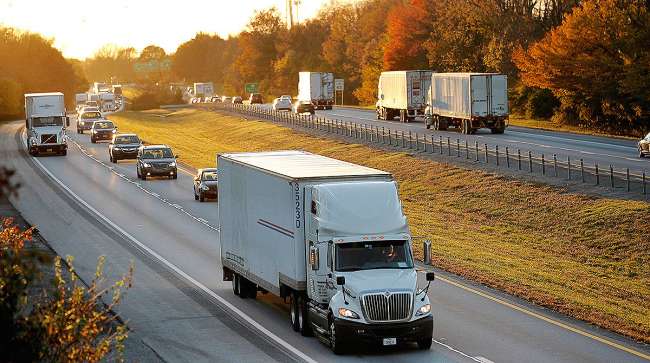Senior Reporter
Truck Tonnage Up 4.3% Year-Over-Year on Coronavirus Surge

[Ensure you have all the info you need in these unprecedented times. Subscribe now.]
Truck tonnage rose 4.3% year-over-year in March on gains in selected business sectors, according to American Trucking Associations.
Still, the impact of COVID-19 on the broader economy is raising questions about what the months ahead will hold for the trucking industry.
The index reached 120.4 (100 represents 2015), and on a month-to-month basis, the index rose 1.2% in March after a 1.8% increase in February.
Many trucking companies have reported brisk business transporting critical medical supplies to hospitals and clinics and keeping grocery stores stocked.
“March was the storm before the calm, especially for carriers hauling consumer staples, which experienced strong freight levels,” ATA Chief Economist Bob Costello said. “But there was a huge divergence among freight types. While freight to grocery stores and big-box retailers was strong in March, especially late March, due to surge buying by households, freight was anemic in other supply chains, like that for gasoline, restaurants and auto factories.”
Costello said the U.S. economy is in a recession, and the gross domestic product could fall 20% to 25% on an annualized basis in the second quarter.
“Because of this, and the continued shuttering of many parts of the economy, I would expect April tonnage to be very soft,” he said.
“March was the storm before the calm, especially for carriers hauling consumer staples, which experienced strong freight levels. But there was a huge divergence among freight types." - @ATAEconBob #Tonnage https://t.co/kaSdo8YsUZ
— American Trucking (@TRUCKINGdotORG) April 21, 2020
Trucking serves as a barometer of the U.S. economy, representing 71.4% of tonnage carried by all modes of domestic freight, including manufactured and retail goods.
ATA calculates the tonnage index based on surveys from its membership and has been doing so since the 1970s.
Meanwhile, Beaverton, Ore.-based DAT Solutions, which operates a network of loads boards and analytics services, said spot rates the week of April 13 fell again across all three equipment types — flatbeds, refrigerated units and vans.
Spot rates continue to fall for vans, reefers, and flatbeds, and declining load-to-truck ratios signal that a rebound is not happening just yet. https://t.co/wwfmFwdoJs #trucking #logistics #supplychain
— DAT Freight & Analytics (@LoadBoards) April 20, 2020
The report said, “Spot rates have declined rapidly and across the board on high-volume lanes since the third week of March and now rival levels from 2016 when the country was in a manufacturing recession. The national rolling average rates for April fell again across all three equipment types during the week ending April 19 as truckers contemplate whether their next load will cover their running costs.”
- Van: $1.72 per mile, 15 cents lower than the March average.
- Flatbed: $2 per mile, down 19 cents compared with March.
- Reefer: $1.99 per mile, down 20 cents compared with March.
“I think flattening out is probably being pretty optimistic,” Ken Adamo, DAT’s chief of analytics, told Transport Topics. “On the driving side, we saw the market give back all of the gains it experienced during the restocking, and they have essentially plummeted through where they were before restocking, and where they were in 2019, and they have their sights back to 2017, it looks like.”

Adamo
The DAT forecasting models expect spot rates to flatten out in May, and they could be helped by the lifting of some social distancing restrictions and seasonal trends such as produce harvests. But that won’t make up for the business trucking companies lost when schools and universities shut down, and food deliveries stopped to restaurants.
“The supermarket restocking rush was enough to support most of March. But then the fundamentals set in, and a lot of these food goods go to grocery stores, cafeterias for universities, primary schools, and that demand all but evaporated.” Adamo said. “With produce season coming up, the real question is will things open for this fresh produce to be transported towards the tail of April and into May.”
Bloomington, Ind.-based FTR Intel said freight would take a bigger hit in the second quarter with a gradual recovery in the third quarter, but ton-miles will not return to pre-coronavirus levels until 2022.
We are forecasting a bigger hit to freight in Q2 with gradual recovery in Q3. Flash update reports are now available for Freight, Rail Equipment, Commercial Vehicle, and much more https://t.co/j9O8StFe6J#Freight #Rail #Trucking #Shipping #Logistics #Transportation #Economy pic.twitter.com/LJx1fZeCog
— FTR (@FTRintel) April 21, 2020
FTR is revising its 2020 truck loadings from a 4% decline to 9%.
By sectors, reefer trucks fared the best, projected to be down 1% for the year because of the need to ship refrigerated food and critical, temperature-sensitive medical supplies.
Other sectors do not fare as well. Dry van loadings are forecast to decline 7%, tankers, which are impacted by the rapid decline in petroleum shipments, could fall 8%, flatbed loadings are projected to slip by 12%, and bulk/dump loadings are forecast to slump by 17%.
Like the economic projections from ATA’s Costello and DAT, FTR said the late-March rush to restock grocery stores and other critical facilities is over.
“Americans had rapidly depleted grocery stores of a wide range of food and paper products, and carriers were busy with the effort to restock stores and distribution centers,” the April 16 report said. “We knew that this increased demand was temporary and further presumed that conditions would change rapidly, creating a whiplash effect, especially for dry van. Cooling began in late March, and by the week ended April 3, the destruction of freight demand resulting from the economic shutdown clearly overshadowed any remaining restock pressure.”
Want more news? Listen to today's daily briefing:




